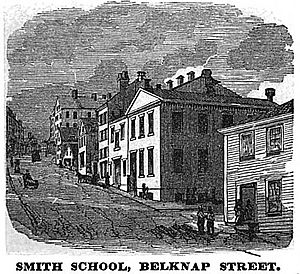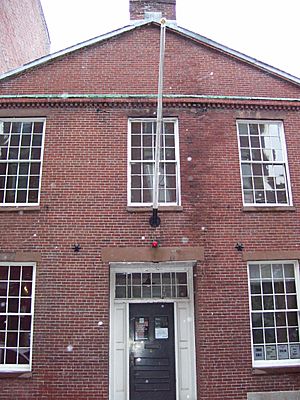Abiel Smith School facts for kids
Quick facts for kids Abiel Smith School |
|
|---|---|

Abiel Smith School, 2007
|
|
| Location | |
|
United States
|
|
| Information | |
| Established | 1835 |
The Abiel Smith School was one of the first public schools in the United States built just for black children. It opened in 1835 in Boston, Massachusetts, at 46 Joy Street. The school stands right next to the famous African Meeting House.
The school was named after Abiel Smith, a wealthy white man who wanted to help others. In his will, he left about $4,000 to the city of Boston to pay for the education of black children. The city used this money to build the school.
Today, the Abiel Smith School building is an important historical site. It is part of the Beacon Hill Historic District and a stop on the Boston Black Heritage Trail. It is also part of the Boston African American National Historic Site.
Contents
History of the School
An Early School for Black Children
Before the Abiel Smith School was built, the African-American community in Boston had already started its own school. In 1798, they began holding classes in the home of a community leader named Primus Hall.
Later, when the African Meeting House was built, the school moved into a classroom on the first floor. The community asked the city for support, and in 1812, Boston began giving some money to help run the school.
Building the Abiel Smith School
The community wanted a proper school building for their children. Help came from Abiel Smith, a white philanthropist (a person who gives money to good causes). When he died, he left money to the city specifically for educating black children.
The city used Smith's donation to build a new school right next to the African Meeting House. They hired an architect named Richard Upjohn to design it. This was Upjohn's first big public project, and he later became famous for designing churches.
When the Abiel Smith School opened in 1835, it replaced the small classroom in the Meeting House. All black students in Boston were sent to this new school.
The Fight for Equal Education
Even with a new building, the school was not equal to the schools for white children. The conditions were not as good, and parents had to keep pushing the city for improvements.
A man named Thomas Dalton was a leader in this fight. He and other parents wanted to make sure their children received a good education and had the same rights as everyone else. They worked to elect people to the city's School Committee who would support their cause.
The main goal was to integrate the schools, which means allowing black and white children to attend school together. In 1849, a court case called Roberts v. City of Boston went to the Massachusetts Supreme Court. The court decided that having separate schools was allowed.
However, the community did not give up. Parents, with the help of activists like Benjamin F. Roberts, took their case to the state government. Finally, in 1855, a new law was passed that made separate schools illegal in Massachusetts. Boston's schools were officially integrated, and the Abiel Smith School closed that same year.
The School's Legacy Today
The Abiel Smith School building still stands as a reminder of this important history. It is a protected National Historic Landmark and part of the Museum of African American History.
After a major renovation was finished in 2000, the building now holds the museum's offices. It is a key part of the Boston African American National Historic Site, which tells the story of Boston's black community.
Famous Student
- William Cooper Nell - He became an author and a leader in the fight to end slavery and integrate Boston's schools.



